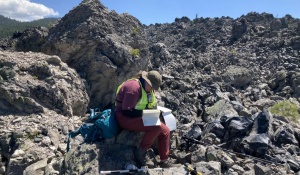Blocksize distribution at Big Obsidian Flow, OR
By: Cassaundra Huggins (cassaund@buffalo.edu)
Advisor: Tracy Gregg, PhD
Earth Science Department
Project Objetives
• Block sizes of silica rich lava flows should decrease from vent to margin due to increased strain during emplacement.
• Block size distribution reveals information about flow rates during emplacement and informs hazard assessments.
Data and Results
• Block sizes were recorded in two areas on flow margin: obsidian and pumice.
• Longest axis >15 cm, shortest axis, and block type were recorded.
• Graphs, sketches, handheld LiDAR images were made.
• Preliminary findings show texture variations (obsidian vs. pumice) are more pronounced than block size variations on margin of flow.
Significance
• Silica rich lava flows are commonly analogues for volcanic features of other planetary bodies that are interpreted to be silica rich.
• Visible surface textures and variations may provide better criteria for analogue selection. Ex. Gruithuisen Domes on the Moon.
Lunar and Planetary Science Conference 2025
Huggins, C. D., Gregg, T. K. P., Garry, W. B., and
Yingst , A. (2025). Geologic Map of the Lunar Gruithuisen Delta Dome.
Poster presented at the 56th Lunar and Planetary Science Conference, The Woodlands, TX. Abstract (2398) retrieved from https://www.hou.usra.edu/meetings/lpsc2025/pdf/2398. pdf. (Poster presentation)

Cassaundra Huggins recording block sizes in field notebook on margin of Big Obsidian Flow, Oregon